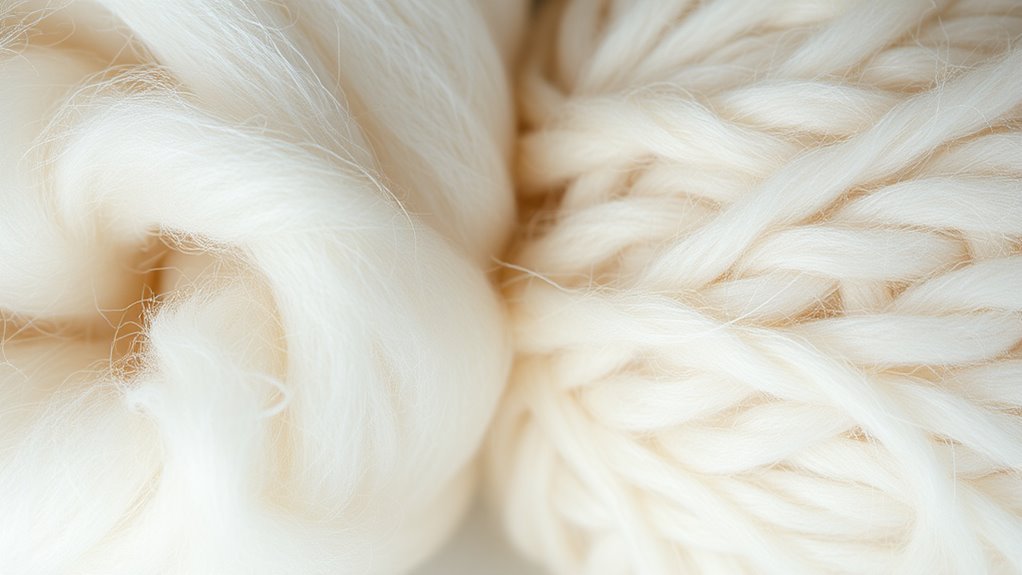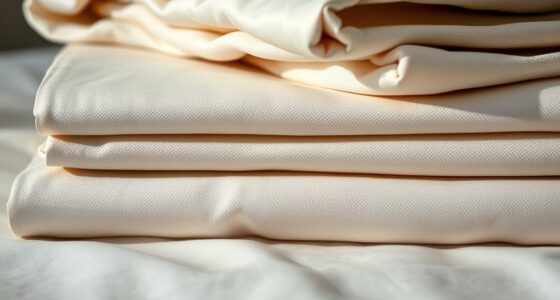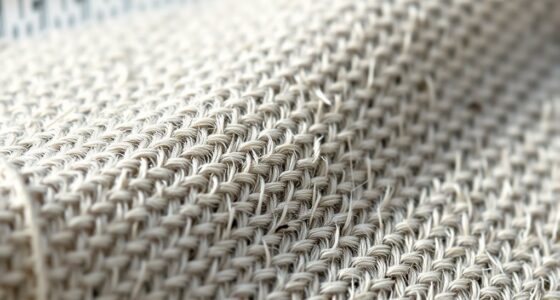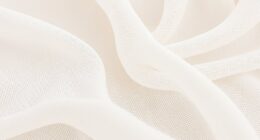When comparing cashmere and Merino wool, you’ll find Merino is more durable and easier to care for, making it ideal for everyday luxury. Cashmere feels softer and warmer but requires gentle handling to maintain its beauty over time. Both can be sustainable when sourced responsibly, but overgrazing and fiber delicacy are concerns. To choose what suits your needs best, understanding their qualities and sourcing methods is key—discover more details below.
Key Takeaways
- Merino wool is more durable and resilient, ideal for everyday luxury garments, while cashmere offers superior softness and warmth.
- Cashmere is finer and more delicate, requiring careful maintenance to prevent pilling and stretching.
- Both fibers can be sustainably sourced, but Merino wool’s durability extends its lifespan, reducing waste.
- Cashmere provides unmatched luxury feel but may need frequent replacement if not properly cared for.
- Ethical sourcing practices are essential for both fibers to ensure environmental sustainability and animal welfare.
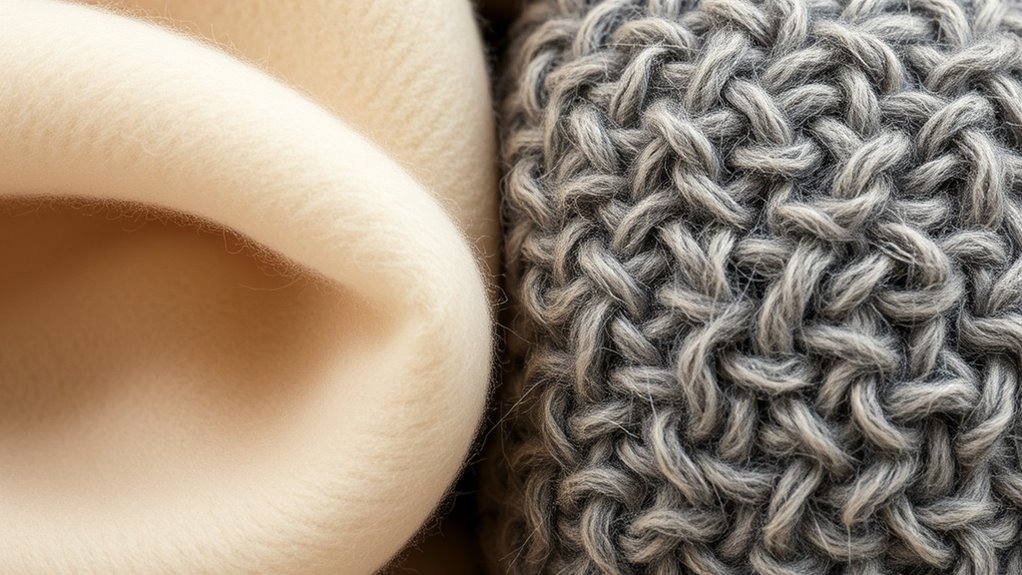
When choosing luxury wool, understanding the differences between top-quality options can help you make an informed decision. Cashmere and Merino wool are two of the most sought-after fibers in the luxury market, each offering unique qualities that appeal to different preferences. One of the key factors to weigh is fiber durability. Merino wool is renowned for its resilience; it’s a strong, elastic fiber that can withstand daily wear without losing its shape or softness. This durability makes it ideal for everyday luxury garments, ensuring your investment lasts for years. Cashmere, while incredibly soft and warm, tends to be more delicate. Its fibers are finer and more prone to pilling or stretching over time, so it often requires gentle handling and careful maintenance. If you’re seeking a piece that maintains its appearance through regular use, Merino might be the better choice.
Another important aspect is eco-friendly sourcing. Both fibers can be produced sustainably, but their sourcing practices differ markedly. Merino wool is often farmed in regions like Australia and New Zealand, where sheep are raised under strict environmental and animal welfare standards. Sustainable Merino farms prioritize rotational grazing and land management techniques that protect ecosystems. Cashmere, on the other hand, comes from Cashmere goats primarily found in Mongolia, China, and Central Asia. The best producers practice eco-friendly sourcing by ensuring humane treatment of goats and implementing sustainable grazing practices to prevent overgrazing, which can damage fragile environments. When selecting either fiber, researching brands that emphasize ethical and eco-conscious sourcing can help you enjoy luxury with a clear conscience.
The differences in fiber durability and sourcing practices also influence the overall sustainability of your purchase. Merino wool’s resilience means fewer replacements and less waste over time, aligning with eco-friendly principles. Cashmere’s luxurious softness, if sourced responsibly, can also be a sustainable choice, especially when you prioritize brands committed to ethical farming and environmental stewardship. Both fibers offer eco-friendly options, but it’s essential to look beyond the fiber itself and examine the sourcing methods behind the product. Additionally, considering the popularity of remote hackathons can be a useful way for industry professionals to collaborate on sustainable sourcing solutions and innovative practices.
Ultimately, your choice depends on your priorities: if you want a highly durable, low-maintenance fabric with a focus on eco-friendly sourcing, Merino wool might be your best bet. If softness and warmth rank higher and you’re willing to invest in proper care, cashmere offers unmatched comfort and elegance. By understanding fiber durability and sourcing practices, you’ll be better equipped to select a luxury wool that aligns with your values and lifestyle.
Frequently Asked Questions
How Do Cashmere and Merino Wool Differ in Warmth?
You’ll find cashmere warmer than Merino wool because of its higher fiber density, which provides superior insulating properties. Cashmere fibers are finer and more tightly packed, trapping more air and retaining heat effectively. Merino wool, while still warm and breathable, has slightly lower insulating qualities due to its thinner fibers. So, if warmth is your priority, cashmere offers a cozier experience, but Merino still keeps you comfortable in milder conditions.
Which Wool Is More Resistant to Pilling?
Surprisingly, merino wool wins the battle against pilling resistance, making it more durable for everyday wear. While cashmere feels luxuriously soft, it’s actually more prone to pilling over time, which might surprise you given its elegance. If fabric durability is your priority, merino’s tighter fibers help it resist pilling, keeping your garments looking fresh longer. So, don’t let softness fool you—merino’s resilience outshines cashmere here.
Are Cashmere and Merino Wool Suitable for Sensitive Skin?
If you have sensitivity concerns or skin irritation, both cashmere and merino wool can be suitable options, but it depends on your skin. Merino wool is often softer and less itchy, making it a good choice for sensitive skin. Cashmere is luxurious and gentle but can sometimes cause irritation if your skin is very sensitive. Always opt for high-quality, well-washed wool and consider a test patch to guarantee comfort.
How Should I Care for and Clean Each Type of Wool?
To properly care for your cashmere and merino wool, focus on gentle wool maintenance and cleaning techniques. Hand wash them in cold water using mild detergent, or opt for dry cleaning if needed. Avoid wringing or twisting; instead, gently squeeze out excess water and lay flat to dry. Store your wool items folded in a cool, dry place, and avoid direct sunlight to preserve softness and prevent damage.
What Are the Environmental Impacts of Producing Cashmere Versus Merino Wool?
Like a careful steward tending a garden, you recognize that producing cashmere often involves overgrazing, which harms the environment, whereas merino wool’s sustainability benefits from more ethical sourcing and sustainable farming practices. Merino wool generally has a lower environmental impact due to less intensive farming and better land management. By choosing ethically sourced merino, you support eco-friendly practices, helping to preserve ecosystems and reduce the carbon footprint associated with luxury wool production.
Conclusion
When choosing between cashmere and merino, think about your comfort and style. Cashmere feels like wrapping yourself in a cloud, perfect for those special occasions, while merino’s durability makes it your go-to for everyday adventures—no need to be a knight in shining armor. Both are timeless, like a fine piece of art. So, weigh your needs, and don’t forget—whether you’re a modern-day Robin Hood or a Victorian dandy, luxury wool has got you covered.
